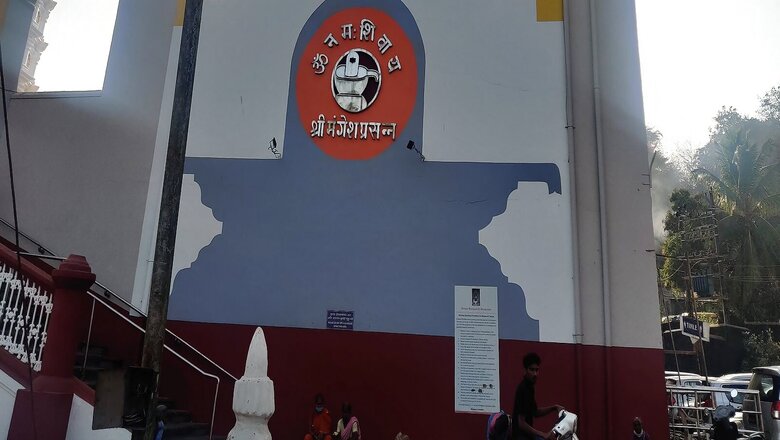
views
With the unfurling of flags in each house for celebrating the 75th year of freedom, it is time to reclaim/cherish the heritage preserved by the defenders of Hindu dharma and culture.
Bharat, even after more than five centuries of Muslim and two centuries of European rule, has been able to sustain its identity.
This was the time when invaders of Bharat with all their might were carrying their objective of the destruction of Hinduism. With the zeal to convert and annihilate the culture, they fought for power and its wealth. And the reason Hindus were able to sustain was that they fought in defence of something which they valued above their very lives. This was the exceptional untold history of a relationship between the Goans and their Hindu deities. When the colonial power with the faulty theology (considering Christianity superior) of religious conversion started their conquest of destruction and persecution, a parallel movement was started by the people of Goa to conserve the rich ancestral heritage of their beloved Gods and Goddesses.
In preserving the colonial imprints which gave Goa an illusion of uniqueness, we have somehow forgotten about the millennium-old Hindu culture of Goa. It is time to reintroduce us to some of the unique temples that faced destruction, but their deities were protected by devotees.
Located 17 km from the state capital Panaji, Marcel in Ponda taluka is home to some of the most sacred Hindu temples in Goa. It is Shree Devkikrishna Ravalnath temple Saunsthan, which has among the most ancient temples. Originally, these were set up by the Saraswat Brahmans in Goa. The Saraswat Brahmans were brought by Sri Parshuram in the ancient period. Among the temples of Shree DevkiKrishna Ravalnath temple Saunsthan, Sri Devkikrishna temple is of great religious significance.
There are many temples of Sri Krishna and, Radhakrishna’s temple is the most common. Being separated from his mother at birth, there is no temple where Mother Devki and Bal Krishna are worshipped together. The temple has the distinction of being the only temple in Bharat where Sri Krishna’s biological mother Devki is worshipped along with Bal Krishna (Sri Krishna in child form). The presiding deity is a beautiful nurturing idol form of mother Devki. It is in a standing form where she is holding the image of little Krishna on the left side of her belly with her left arm. History says that Vasco da Gama in his old age was appointed Vice-Roy of all colonies of the Far East as a gesture of honour. On his visit to Chodan Island, when he saw this idol through the main doorway, he immediately saluted the image and went to his knees. The history of the temple is largely confined to songs and tales which have been preserved by devotees.
The original site of the temple was on Chodan island of Tiswadi taluka. There are many legends associated with the place. It finds a mention in Mahabharat too. In Mahabharat’s period, Chodan was a thick jungle. Legend has it that during the times, a battle was fought between Krishna and Balaram on one side and Jarasandha on the other. When chased by the powerful Jarasandha, God decided to take refuge in Gomanchal Parvat. Devki ji, the biological mother of Sri Krishna who was anxious to see her son, became restless. She traveled all the way from Mathura to Gomanchal Parvat, there when she came face to face with Sri Krishna she could not believe that her baby Krishna has grown. She thought it to be a spell caused by some evil forces to fool her and that her son little Bal Krishna’s life was in danger. When Krishna inquired why she was so indifferent when he was her ‘Devkinandan’ (son of Devki), she replied, “How can you be my son? My son is Balkrishna”.
At this juncture, Sri Krishna realized that since childhood he had not met his mother as he left for Dwarka early, and the image Devki carried of him was of a child. Sri Krishna instantly appeared in the form of a small child and embraced her. Devki instantly lifted the child and took him in her lap. The story of Devkikrishna and its association with the symbolic idol is a rare one. The meeting place is also unique, the island of Chudamani, Chorao, or Chodan, where Krishna had gone hiding.
The islands of Goa and Divar, Jua and Chodan were the first territories conquered by the Portuguese, so they faced the onslaught of Christianity first. The Hindu temples which existed in this territory were destroyed by 1540.
In his exceptional work ‘Goa: Hindu Temples and Deities’, a book on Goa’s history from 1510-1961, which covered the period of Portuguese rule of oppression, conflict, struggle, and adaptation, Rui Gomes Pereira wrote: “In the vast art gallery that India is, Goa should have occupied a prominent place had not the Portuguese destroyed all its temples, sparing none. The Old Conquests which were under their dominion in the most critical hour of religious frenzy saw no stone left unturned. Everything was destroyed without leaving a vestige.”
Periera further wrote, “It was the time when the persecution of Hindus was sanctioned by royal orders and executed brutally by Christian Missionaries. With the first provision of law on June 30, 1541, it was made known that the King had ordered the destruction of all Hindu temples without leaving a single one within Portuguese territory of Ilhas. This order was carried out and in the same year most of the temples were demolished it was Vicar General, Miguel Vaz, who took an active part in it persecuting the Hindus to the extent of forcing them to destroy their temples with their own hands.”
The ‘Carta Regia’ (royal decrees) forbidding Hindus to construct, repair, or finance their temple was passed. Brahmans were exiled. Celebration of Hindu festivals or performing of Hindu rituals were banned as these might offend the Christian population. It was not just temples, but the deities wherever found were brunt, broken, and desecrated. Even the land and income of these forsaken temples were not spared, it was used in the building and services of churches.
Facing this destruction, many Hindus of Goa who wanted to protect their religious traditions and culture and most importantly to save their most revered idols started migrating to non-Portuguese ruled regions taking with them their precious deities. That is how DevkiKrishna temple was first shifted to Mayem of Bicholim Taluka and then to Marcela of Ponda Taluka through the Cumbarjua canal in canoes.
The Devkikrishna was not the only temple to be destroyed by the Portuguese. Although Missionaries of Church destroyed almost all temples of Goa, till date traces of the old Chodan temple are seen much like the broken images and art pieces of the ancient times which were found buried in wells and tanks to escape the devastating hands of the Portuguese missionaries. The destruction under five-century foreign rule left fragments of images found, and of which some were lost, in the foundations of churches and other Portuguese structures.
Although the missionaries were successful in taking away the temple gold, land, and almost everything belonging to the Hindu identity of the community, what was not taken from them was their determination to repair the damage. Many of the demolished temples were reconstructed in safer regions, deities reinstalled and they prospered.
Besides Sri DevkiKrishna temple, the Saunsthan is house to many other deities which were smuggled to escape the destruction frenzy of Portuguese-Church. As per their website, on the history of the Saunsthan, it says after this migration to safer areas, “The Saraswats Brahmans assimilated with the locals and a cordial relationship followed. Similarly, the followers of Devkikrishna accommodated Ravalnath and Bhumika in their folds and paved a cordial and brotherly relationship. This is the reason we see devotees of other communities at many temples. This is the only temple dedicated to Devkikrishna in the entire world. There are of course a handful of temples dedicated to Devkikrishna with similar idols but they are essentially branches of the temple at Mashel (Marcela), established by Mahajans and Kulavis who could not visit the main temple regularly to perform puja and obtain Prasadam. They still consider the deity at Mashel, their main source of inspiration and visit once a year or so. Over a period of time and with the advancement of transport, the gap is narrowing down and it is only a matter of time before the temple regains its full past glory.”
On this auspicious day when temples are celebrating Sri Krishna Janmashtami, people shower their love and reverence on little Krishna on the day of his birth and are ecstatic watching his Bal-Leelas.
It is time to value our Azadi which gives us freedom to carry forward the rich religiousness of our ancestors and cherish the culture and religion of Bharat, which like the Sun and Moon is constant and never-ending.
The writer is PhD in Sociology and senior fellow with Delhi based think tank Vichar Vinimay Kendra. The views expressed in this article are those of the author and do not represent the stand of this publication.
















Comments
0 comment